
still need the previous edition?
![]() .Events .Moon .Planets .Major Events .Minor Planets, NEOs .Comets .Shooting Stars .Occultations .Sun .check more! (occultations observers are advised to check in 'Events', and to turn to such dedicated sites like the I.O.T.A). don't forget to check the weather! For the US: the NOAA . color codes: Wwd worldwide, UsA USA-Americas, EuA Europe-Africa, AsP Asia-Pacific, Chk Check for Your Zone. check the site's concept and the instructions of use
.Events .Moon .Planets .Major Events .Minor Planets, NEOs .Comets .Shooting Stars .Occultations .Sun .check more! (occultations observers are advised to check in 'Events', and to turn to such dedicated sites like the I.O.T.A). don't forget to check the weather! For the US: the NOAA . color codes: Wwd worldwide, UsA USA-Americas, EuA Europe-Africa, AsP Asia-Pacific, Chk Check for Your Zone. check the site's concept and the instructions of use
![]()
![]() Editor's
Choice Fine Picture Archives
Editor's
Choice Fine Picture Archives ![]() Editor's Choice Sky At
Editor's Choice Sky At ![]()
![]()
![]() Tech News
Tech News ![]() color codes: Wwd worldwide, UsA USA-Americas, EuA Europe-Africa, AsP Asia-Pacific, Chk Check for Your Zone. check the site's concept and the instructions of use
color codes: Wwd worldwide, UsA USA-Americas, EuA Europe-Africa, AsP Asia-Pacific, Chk Check for Your Zone. check the site's concept and the instructions of use
| Tweet |
.Events Seen All Month Long .Ephemerides Proper
(data from the former yearly ephemerides generator at Fred Espenak's NASA's eclipse website; miscellaneous data with the 'Astronomical Phenomena for The Year 2017,' a joint work by the United Kingdom Hydrographic Office and the U.S. Naval Observatory; to be found at the latter's site; all time UT except otherwise stated)
Wwd Beginning Jan.15, until by Jan. 30, Venus is seen moving like a morning star, close to Jupiter by dawn! A closest is reached by about Jan. 21. Fine visual and photographic opportunities as Antares, the bright star to Scorpius, the Scorpion is not that far, or the Moon will come adding!
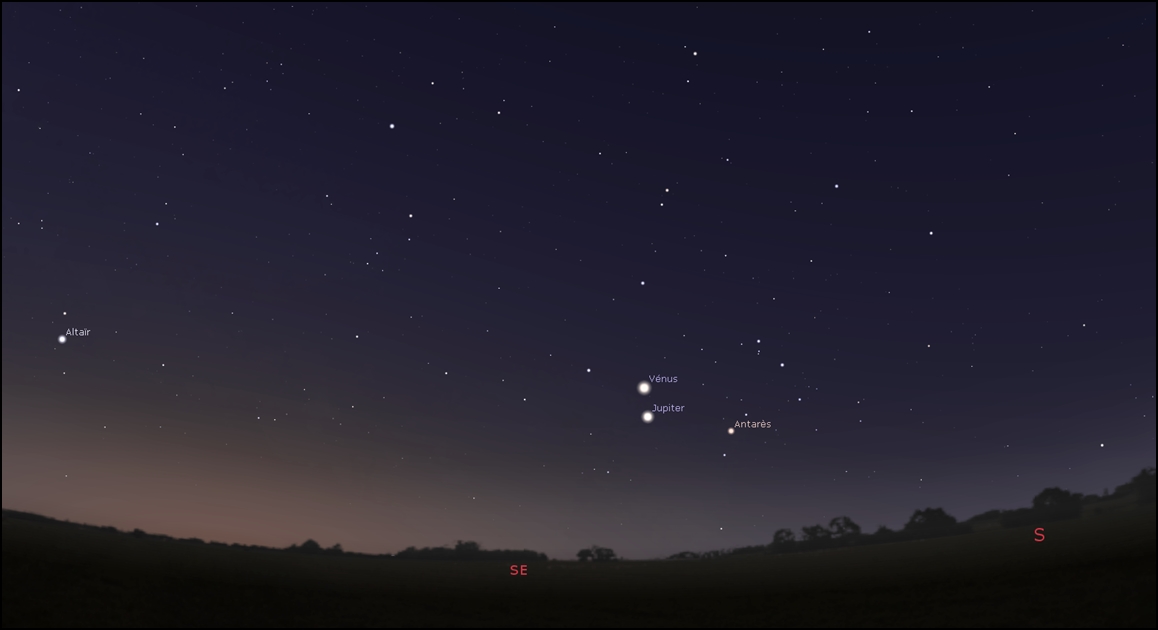 | Venus is moving by Jupiter in the morning twilight as Antares is not that far! picture site 'Amateur Astronomy' based upon Stellarium |
Wwd In the northern hemisphere only, the three main stars to the Summer Triangle, that distinctive feature of the summer skies, are seen like evening stars northwest!
Wwd At the Tropics and the southern hemisphere only, a whole set of fine constellations are seen embedded into the Milky Way on the southern horizon by dawn! Fine visual, or photographic opportunities as Moon will also come to add! The show is higher in the southern hemisphere!
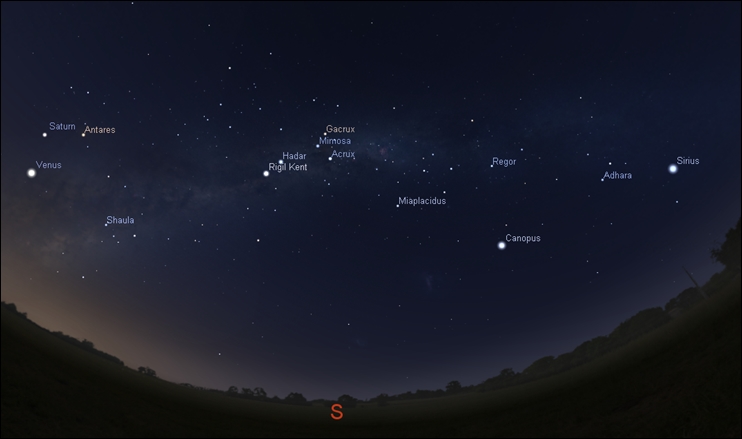 | Milky-Way embedded fine constellations seen South by dawn at the Tropics and the southern hemisphere! picture site 'Amateur Astronomy' based upon Stellarium |
1 (1) EuA AsP Chk Tomorrow morning by dawn, at all latitudes, last crescent Moon is seen close to Venus. Fine visual and photographic opportunities as Antares, the bright star to constellation Scorpius, the Scorpion or Jupiter are not that far. The show is seen the morning before for the USA-Americas area
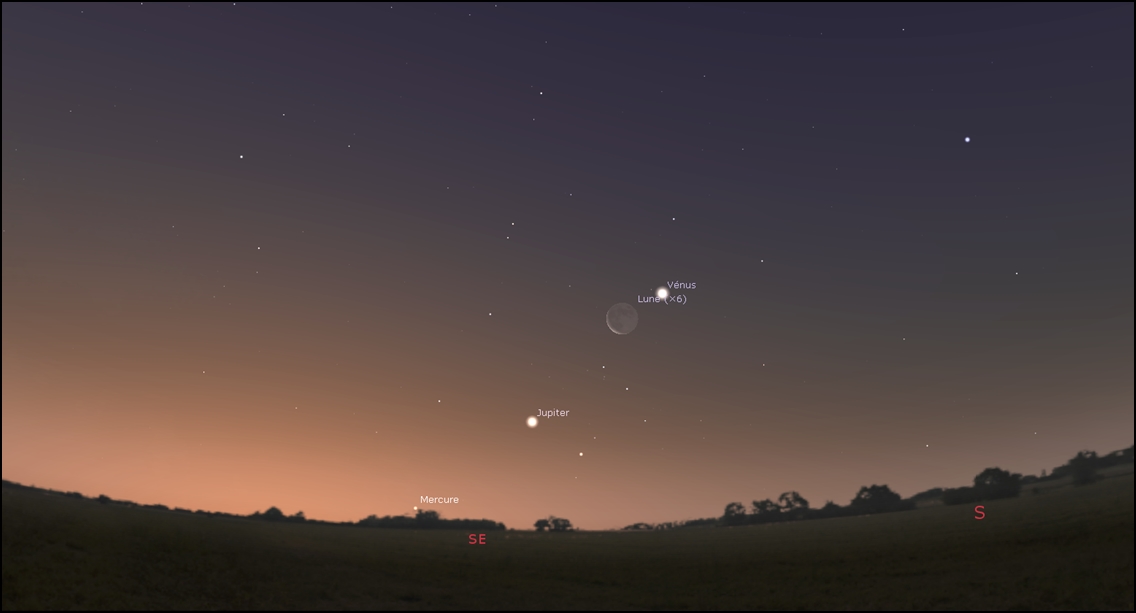 | Moon close to Venus as Jupiter and Antares not that far! picture site 'Amateur Astronomy' based upon Stellarium |
1 (2) Wwd The Quadrantids, one of the most important meteor showers of the year, usually begin to be active today as they are until next Jan.5. They usually are peaking on Jan. 2-3. more at the date of the peak
2 (1) Wwd Tomorrow morning by dawn, by all latitudes, very last crescent Moon is seen close to Jupiter. Fine visual and photographic opportunities as Antares, the bright star to constellation Scorpius, the Scorpion, or Venus are not that far
2 (2) Wwd The Quadrantids are peaking on Jan 2-3 more back
3 Wwd Earth, like each year by about this date, is at its perihelion today by 9:59 UT. The Earth is at its closest to the Sun as it paradoxically is winter days in the northern hemisphere. check more details about the aphelion-perihelion concepts with our tutorial Seasons
5 Wwd Moon reaches a southernmost declination at 18:46 UT
6 Wwd The first solar eclipse -- and first major astronomical event in 2019 -- occurs today, a partial solar eclipse, the partial solar eclipse of January 6th, 2019. check more
7 Wwd Moon is at a descending node at 00:08 UT
9 Wwd Moon is at its apogee at 04:29 UT (distances non available)
12 UsA EuA First quartered Moon by all latitudes, is close to Mars tonight! Fine
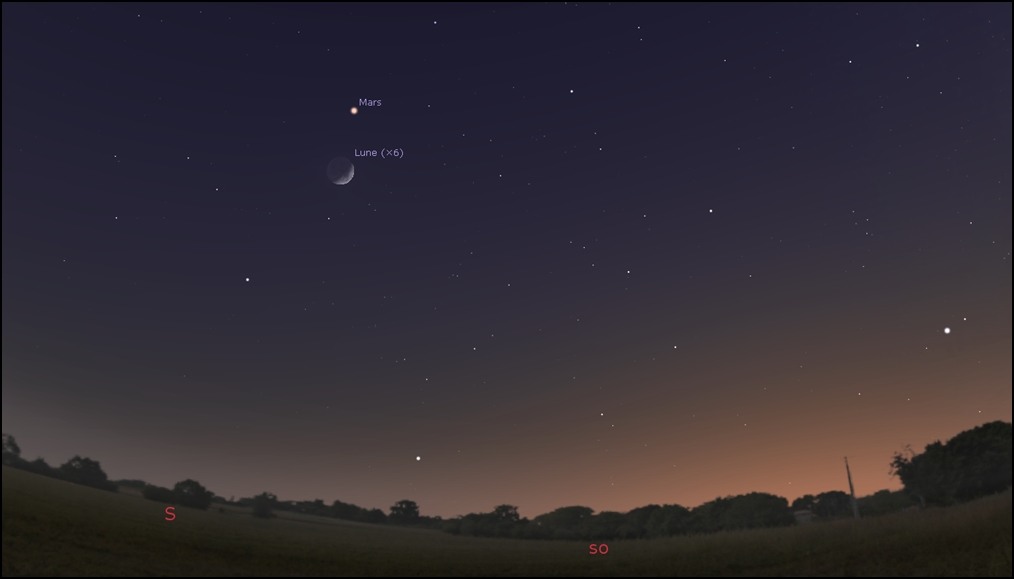 | Moon close to Mars tonight! picture site 'Amateur Astronomy' based upon Stellarium |
13 AsP Chk First quartered Moon at all latitudes, is close to Mars tonight! Fine. The show is better seen the day before in the northern hemisphere of the area
17 Wwd Waxing gibbous Moon at all latitudes, is close to Aldebaran tonight, the bright star to constellation Taurus, the Bull
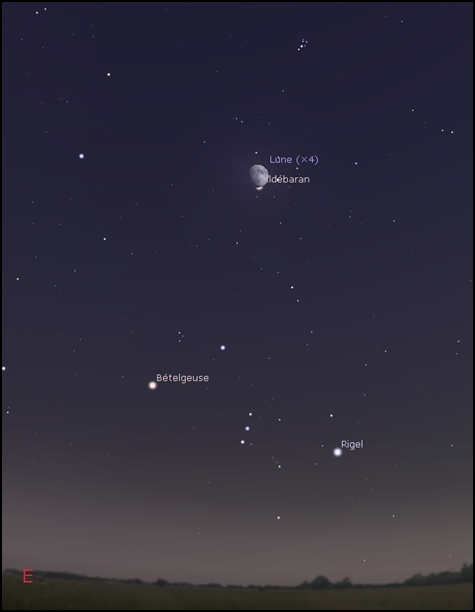 | Moon close to Aldebaran tonight! picture site 'Amateur Astronomy' based upon Stellarium |
19 Wwd Moon reaches a northernmost declination at 23:20 UT
20 Wwd Moon is at a ascending node at 22:48 UT
21 (1) Wwd That first lunar eclipse for 2019 occurs today, the total lunar eclipse of January 21st, 2019. check more
21 (2) Wwd Moon is at its perigee at 19:58 UT (distances non available)
22 UsA EuA Full Moon by all latitudes, is close to Regulus tonight, the bright star to constellation Leo, the Lion
23 AsP Chk Full Moon is close to Regulus at all latitudes tonight, the bright star to constellation Leo, the Lion. The show may be seen also the day before at the Tropics of the area as it is better seen the day before in the northern hemisphere of the area
30 Wwd Tomorrow morning, last crescent at all latitudes, is seen close to Jupiter by dawn as Venus or Antares are not that far. Fine visual and photographic opportunities! Moon is closer to Venus for the USA-Americas area
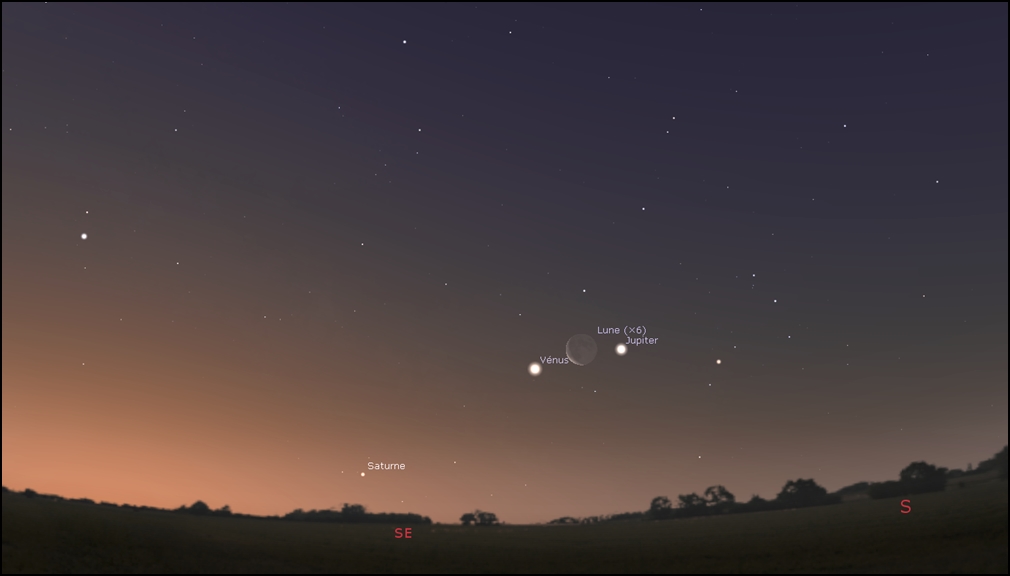 | Moon close to Jupiter with Venus and Antares not that far! picture site 'Amateur Astronomy' based upon Stellarium |
31 Wwd There is a occultation of Venus today by Moon! check more at Occultations; check more too at such sites like "The International Occultation Timing Association" (I.O.T.A.)
Occultations observers are advised to turn to such dedicated sites like the I.O.T.A as they may also check below at our Occultation section
New Moon is on January 6th, at 01:28 UT
First Quarter is on January 14th, at 06:46 UT
Full Moon is on January 21st, at 05:16 UT
Last Quarter is on January 27th, at 21:11 UT
(source: ephemeris generator at Fred Espenak's NASA's eclipse website)
for what a remarkable configuration of a planet is, check our tutorial 'Planets Apparent Motion'
Mercury is reaching a superior conjunction on Jan. 30 by 02:46 UT as the swift planet that month mostly remains unobservable, or of no avail worldwide
Venus is a fine morning star worldwide
Mars Mars Observation Campaign! is a much high evening star, before northwest, in the northern hemisphere as it is closing to the zenith by twilight at the Tropics. Mars in the southern hemisphere is more readily a evening star by northwest. The Mars Observation Campaign 2018-2019 is ending by February 2019 when Mars back to 6" of apparent diameter, a value afficionados deem the least observable. check more at our Mars Observation Campaign 2018-2019 page
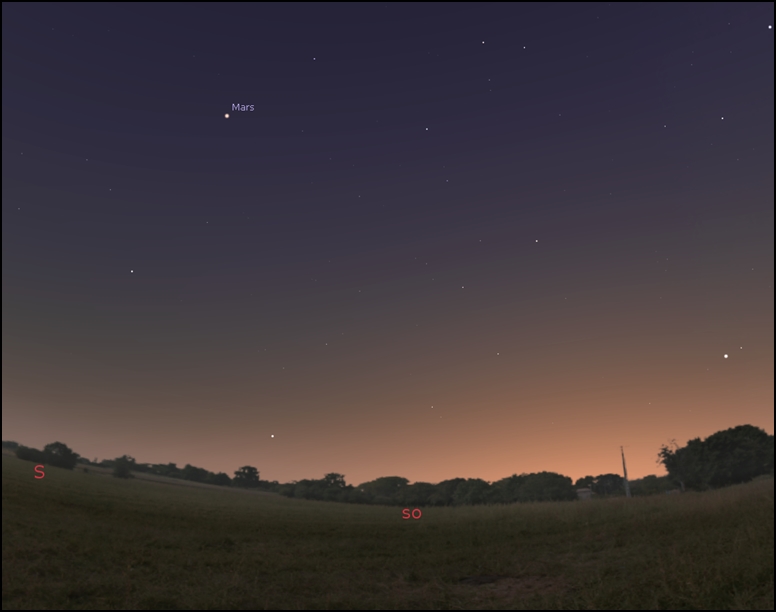 | Mars is a high evening star in the northern hemisphere! picture site 'Amateur Astronomy' based upon Stellarium |
Jupiter, after a conjunction last December 2018, is now a fine morning star worldwide
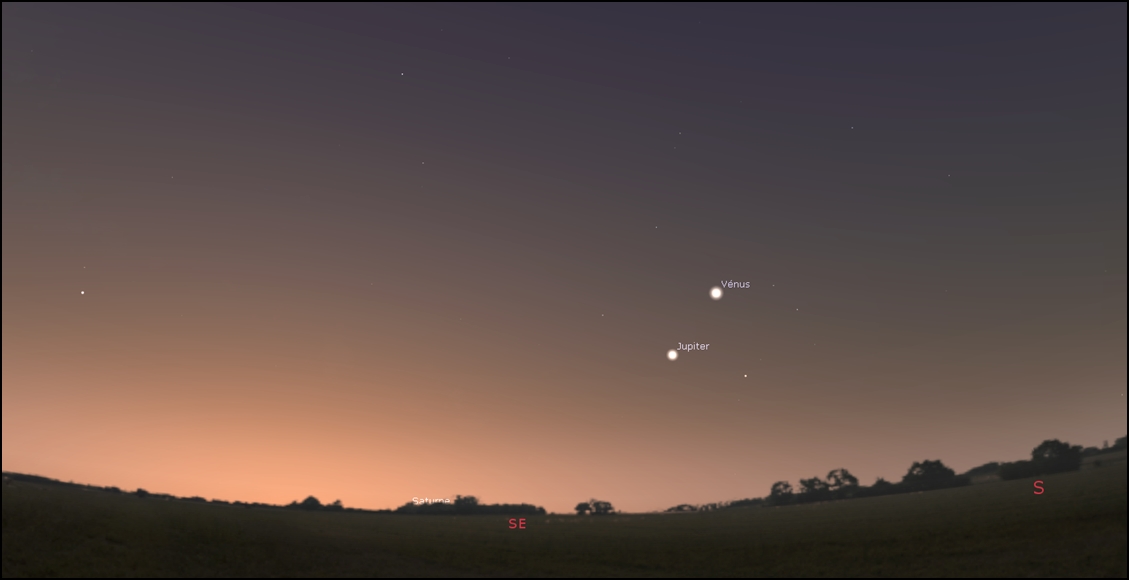 | Venus, or Jupiter, are fine morning star! picture site 'Amateur Astronomy' based upon Stellarium |
Saturn is reaching its yearly conjunction on January 2nd, 2019 by 04:53. Following a ring aperture maximum, rings now are closing
Uranus keeps observable in the northern hemisphere, at the Tropics, or the southern hemisphere (albeit lower there)
Neptune keeps observable in the northern hemisphere -- due to a early twilight -- and the Tropics, which is not true in the southern hemisphere
Pluto is now at its yearly conjunction and not observable worldwide (according to the International Astronomical Union (IAU) since 2006, Pluto is not considered a planet anymore, but categorized like a dwarf planet instead along with Ceres, Eris, Makemake, and Haumea, and the prototype of a new category of 'trans-Neptunian', 'Pluto-class' objects)
The Partial Solar Eclipse of January 6th, 2019
The Total Lunar Eclipse of January 21st, 2019
That first solar eclipse -- and first major astronomical event in 2019 -- is a partial solar eclipse, the partial solar eclipse of January 6th, 2019. That partial eclipse will be moving from eastern Far East to from the Bering Strait to eastern Pacific, and from the Kamchatka Peninsula, North to the mid-Pacific ocean, South. The more away southwards, the less the Sun will be indented down to the eclipse's boundaries. check our page dedicated to that event
| CAUTION! OBSERVING A SUN ECLIPSE IS DANGEROUS AND MAY CAUSE IRREVERSIBLE EYE DAMAGE, UP TO BLINDNESS, ANNULAR AND PARTIAL ECLIPSES INCLUDED! Observing a Sun eclipse necessitates DEDICATED SAFE TECHNIQUES! |
That first lunar eclipse for that year is the total lunar eclipse of January 21st, 2019. The entirety of the total eclipse will be seen for the whole of Americas, Greenland, Iceland, UK, or most of Scandinavia. Areas either part of that either will have the eclipse by moonrise, like from Alaska Aleutian Islands to southwestern Pacific Ocean, or the eclipse by moonset, like for central Siberia in Russia down to whole of Africa, or most of Europe. No eclipse is seen from Mongolia to India and Australia. check our page dedicated to that event
Minor planets are those biggest asteroids in the Asteroid Belt which may be easily observed by amateurs from the Earth, namely Ceres, Pallas, Juno, and Vesta (due to the new categorization by the International Astronomical Union (IAU) by 2006, Ceres belongs to the 5 dwarf planets in the solar system with Pluto, Eris, Makemake, and Haumea). check data and charts at our section Minor Planets on the yearly Calendar page as our tutorial 'Asteroids and Asteroid Hunting' is of help too. Any remarkable event linked to a minor planet may have a notice here below
Some small asteroids dubbed Near-Earth Objects (NEOs) are regularly making close approaches at Earth. People interested in such close approaches may obtain recent and upcoming data at NASA site Near-Earth Object Program (their section "Close Approaches"). Date, miss distance in AU or Lunar Distance (LD), estimated diameter, and relative velocity are available. For further observational purposes, check at the Near-Earth Object Program ephemeris Generator. For more about NEOs see tutorial "
Once every time, the solar system treats us with a remarkable comet, a eery view spanning up to thirty degrees of sky! Most of the time however comets are the domain of dedicated observers as mostly weak and, at the most, hovering at the limit of the naked-eye visibility. A good site to get information about current such comets is the British Astronomical Association Comet Section page or also the Weekly Information about Bright Comets page (which often points to comets close to the visual magnitude). Our 'Comets and Comet Hunting' tutorial will also be helpful. Remarkable comets otherwise usually will be presented below!
->note: shooting stars afficionados will be aware of checking Moon at the dates of the showers
for more about the meteor showers of this month, for possible other meteor showers for this month, and for more about shooting stars, generally, see our tutorial "Shooting Stars"
Each month, Moon occults some relatively bright stars, that is the Moon, beginning either with its bright or its dark visible face, is passing in front of a star. This is called an occultation. The Pleiades, on the other hand, due to their position near the eclipic, are often occulted by Moon too. Some planets, at last, along the year, may be occulted by Moon or they themselves, or their satellites, may be seen too occulting a star. The asteroids too may occult stars. Yearly lists of such phenomenons are to be found at Sky & Telescope/SkyTonight.com, either in their newsstand issues or at their site, as a list of occultations of most brilliant stars, the planets and the Pleiades are available at the I.O.T.A site (I.O.T.A. stands for "The International Occultation Timing Association"). Most notable occultations are signaled below. The configuration of Moon makes 2019 a great year of occultations of planets and minor planets by the Moon as, amazingly none of the bright stars usually occulted by Moon, like Aldebaran, Antares, Regulus or Spica, will be!
Venus back is occulted by Moon on Jan. 31st, 2019 by 18:00 UT! The show is available for E. Micronesia, Polynesia (except Hawaii), Galapagos Is., S. Central America, and N.W. S. America. check more at such sites like "The International Occultation Timing Association" (I.O.T.A.)
check on this site for more about occultations, theoretically
| CAUTION! OBSERVING THE SUN IS DANGEROUS AND REQUIRES DEDICATED SAFE TECHNIQUES! |